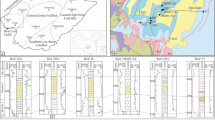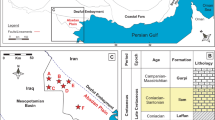Abstract
The understanding of pore structures and controlling factors of different oolitic shoal reservoir types in Lower Triassic Feixianguan Formation around Kaijiang-Liangping Trough has been a key issue restricting efficient exploration and development of such reservoirs. Based on thin section identification, scanning electron microscopy, mercury injection, three-dimensional CT scanning, cathodoluminescence analysis, stable isotope, and rare earth element analysis, the Feixianguan Formation oolitic shoal reservoirs are classified into three types: mold-oolitic dolostone type, residual-oolitic dolostone type, and sparry-oolitic limestone type. The residual-oolitic dolostone possesses the best pore structure and reservoir connectivity. By comparison, the pore structure and connectivity of mold-oolitic dolostone and sparry-oolitic limestone are relatively poor. Based on deposition of oolitic shoals, the main controlling factors for pore structure difference are indicated to be meteoric freshwater leaching and dolomitization. The pore structure of mold-oolitic dolostone reservoir is transformed near the exposed surfaces in the upper-middle portion of shallowing-upward meter-scale cyclic sequences. The mold pores are formed by meteoric freshwater leaching, and then transformed by the late dolomitization. The development of residual-oolitic dolostone is not strongly affected by meteoric freshwater leaching effects, while transformed by seepage-reflux dolomitization. Hydrothermal fluids are involved in the dolomitization process of the oolitic dolostones mentioned above. The emplacement of hydrocarbon preserves primary intergranular pore in sparry-oolitic limestone. Other diagenetic effects are less important for the pore structure of oolitic shoal reservoirs in the study area.










Similar content being viewed by others
References
Adnan A, Shukla UK, Verma A, Shukla T (2015) Lithofacies of transgressive–regressive sequence on a carbonate ramp in Vindhyan basin (Proterozoic): a case of tidal-flat origin from central India. Arab J Geosci 8(9):6985–7001. https://doi.org/10.1007/s12517-014-1720-4
Allan JR, Wiggins WD (1993) Dolomite reservoirs: geochemical techniques for evaluating origin and distribution. AAPG:Continuing Education Course Note Series No.36,129p. https://doi.org/10.1016/0920-4105(95)00034-8
Bashri M, Abdullatif O, Salih M (2017) Sedimentology and facies analysis of Miocene mixed siliciclastic–carbonate deposits of the Dam Formation in Al Lidam area, eastern Saudi Arabia. Arab J Geosci 10(21):472–496. https://doi.org/10.1007/s12517-017-3244-1
Bliefnick DM, Kaldi JG (1996) Pore geometry: control on reservoir properties, Walker Creek Field, Columbia and Lafayette counties, Arkansas. AAPG Bull 80(7):1027–1044. https://doi.org/10.1306/64ED8C82-1724-11D7-8645000102C1865D
Cai CF, He WX, Jiang L et al (2014) Petrological and geochemical constraints on porosity difference between Lower Triassic sour- and sweet-gas carbonate reservoirs in the Sichuan Basin. Mar Pet Geol 56:34–50. https://doi.org/10.1016/j.marpetgeo.2014.04.003
Chen PY, Tan XC, Liu H et al (2014) Formation mechanism of reservoir oolitic dolomite in Lower Triassic Feixianguan formation, northeastern Sichuan Basin, southwest China. J Cent S Univ 21:3263–3274. https://doi.org/10.1007/s11771-014-2299-3
Cruz FE, Eberli GP, Byrnes AP, et al (2006). Petrophysical heterogeneity of a Pleistocene oolitic shoal: lessons for ancient reservoirs. Reservoir Characterization: Integrating Technology and Business Practices: 26th Annual. https://doi.org/10.5724/gcs.06.26.0813
Deng HC, Zhou W, Guo R et al (2014) Pore structure characteristics and control factors of carbonate reservoirs: the middle-lower Cretaceous formation, AI Hardy cloth Oilfield, Iraq. Acta Petrol Sin 30(3):801–812. https://doi.org/10.1134/S1075701514020044
Eren M, Kaplan MY, Kadür S (2007) Petrography, geochemistry and origin of Lower Liassic dolomites in the Aydıncık area, Mersin, southern Turkey: Turkish. J Earth Sci 16(3):339–362. https://doi.org/10.1007/s00015-007-1242-0
Fairchild JJ, Spiro B (1987) Petrological and isotopic implications of some contrasting late Precambrian carbonate, NE Spitsbergen. Sedimentology 34(6):793–989. https://doi.org/10.1111/j.1365-3091.1987.tb00587.x
Guo ZH, Li GH, Wu L et al (2011) Pore texture evaluation of carbonate reservoirs in Gasfield A, Turkmenistan. Acta Pet Sin 32(3):459–465. https://doi.org/10.7623/syxb201103012 (in Chinese)
Hao F, Guo TL, Zhu YM et al (2008) Evidence for multiple stages of oil cracking and thermochemical sulfate reduction in the Puguang gas field, Sichuan Basin. China AAPG Bull 92:611–637.10.1306/01210807090
Hardie LA (1987) Dolomitization:a critical view of some current views. J Sediment Res 57(1):166–183. https://doi.org/10.1306/212F8AD5-2B24-11D7-8648000102C1865D
He YL, Fu XY, Liu B et al (2012) Control of oolitic beaches sedimentation and diagenesis on reservoirs in Feixianguan Formation, northeastern Sichuan Basin. Pet Explor Dev 39(4):434–443. https://doi.org/10.1016/s1876-3804(12)60063-9
Hu WX, Chen Q, Wang XL et al (2010) REE models for the discrimination of fluids in the formation and evolution of dolomite reservoirs. Oil Gas Geol 31(6):810–818. https://doi.org/10.1016/S1876-3804(11)60008-6 (in Chinese)
Huang SJ, Tong HP, Liu LH et al (2009) Petrography, geochemistry and dolomitization mechanisms of Feixianguan dolomites in Triassic, NE Sichuan, China. Acta Petrol Sin 25(10):2363–2372. https://doi.org/10.1016/S1874-8651(10)60080-4
Huang SJ, Huang Y, Lan YF et al (2011) A comparative study on strontium isotope composition of dolomites and their coeval seawater in the Late Permian-Early Triassic, NE Sichuan Basin. Acta Petrol Sin 27(12):3831–3842. https://doi.org/10.1016/S1002-0160(11)60127-6
Jiang L, Cai CF, Worden RH et al (2013) Reflux dolomitization of the Upper Permian Changxing Formation and the Lower Triassic Feixianguan Formation, NE Sichuan Basin, China. Geofluids 2013(13):232–245. https://doi.org/10.1111/gfl.12034
Jiang YQ, Gu YF, Liu F et al (2017) Discovery and exploration significance of Zhongxian-Yuchi oceanic trough and platfrom margin, eastern Sichuan Basin, SW China. Acta Pet Sin 38(12):1343–1355. https://doi.org/10.7623/syxb201712002 (in Chinese)
Jiang YQ, Gu YF, Liu J et al (2018a) The evidence of hydrothermal activity and its significance of Permian-Triassic Strata, Eastern Longgang Area, Northeastern Sichuan Basin. Acta Sedimentol Sin 36(1):1–11. https://doi.org/10.3969/j.issn.1000-0550.2018.002 (in Chinese)
Jiang YQ, Gu YF, Xu CH et al (2018b) Feixianguan Formation lithofacies zoning and its geological significance of Eastern side of Kaijiang-Liangping Trough, NE Sichuan Basin. Nat Gas Geosci 29(8):1067–1077. https://doi.org/10.11764/j.issn.1672-1926.2018.06.008 (in Chinese)
Jiang YQ, He YH, Xing FC et al (2019) Characteristics and significance of microbial mineralization fabric in oolitic limestone: a case from Lower Triassic Feixianguan Formation, northeastern Sichuan Basin. Acta Sedimentol Sin 37(2):268–277. https://doi.org/10.14027/j.issn.1000-0550.2018.132 (in Chinese)
Jin ZM, Tan XC, Guo R et al (2018) Pore structure characteristics and control factors of carbonate reservoirs: the Cretaceous Mishrif Formation, Halfaya oilfield, Iraq. Acta Sedimentol Sin 36(5):981–994. https://doi.org/10.14027/j.issn.1000-0550.2018.078 (in Chinese)
Kawabe I, Toriumi T, Ohta A et al (1998) Monoisotopic REE abundances in seawater and the origin of seawater tetrad effect. Geochem J 32(4):213–229. https://doi.org/10.2343/geochemj.32.213
Li F, Yan JX, Chen ZQ et al (2015a) Global oolite deposits across the Permian–Triassic boundary: a synthesis and implications for palaeoceanography immediately after the end-Permian biocrisis. Earth Sci Rev 149(2015):163–180. https://doi.org/10.1016/j.earscirev.2014.12.006
Li WH, Zhang ZH, Zhang HM et al (2015b) Hydrocarbon source and accumulation in Upper Triassic to Lower Jurassic in the Tongnanba area, northeastern Sichuan Basin. Arab J Geosci 8:2515–2525. https://doi.org/10.1007/s12517-014-1403-1
Li KK, Zhang XF, He XY et al (2018) Modification of dolomitization on pores in oolitic shoal reservoirs of the Feixianguan Formation in the northeastern Sichuan Basin. Oil Gas Geol 39(4):706–718. https://doi.org/10.11743/ogg20180408 (in Chinese)
Luczaj JA (2006) Evidence against the Dorag (mixing-zone) model for dolomitization along the Wisconsin arch? A case for hydrothermal diagenesis. AAPG Bull 90(11):1719–1738. https://doi.org/10.1306/01130605077
Luo ZL (2009) Emei Taphrogenesis and natural gas prospecting practices in Sichuan Basin. Xinjiang Pet Geol 30(4):419–424 (in Chinese)
Ma YS, Guo TL, Zhao XF et al (2007) Deeply buried dolostone reservoir’s generation mechanism of Puguang gas field. Sci China: Ser D 37:43–51
Machel HG, Burton EA (1994) Golden Grove dolomite, Barbados: origin from modified seawater. J Sediment Res 64(4):741–751. https://doi.org/10.1016/0037-0738(94)90010-8
Moore CH (2001) Carbonate reservoirs: porosity evolution and diagenesis in a sequence stratigraphic framework. Elsevier, Amsterdam, p 444
Mresah MH (1998) The massive dolomitization of platformal and basinal sequences: proposed models from the Paleocene, Northeast Sirte Basin, Libya. Sediment Geol 116(3–4):199–226. https://doi.org/10.1016/S0037-0738(97)00107-3
Qiao ZF, Janson X, Shen AJ et al (2016) Lithofacies, architecture, and reservoir heterogeneity of tidal-dominated platform marginal oolitic shoal: an analogue of oolitic reservoirs of Lower Triassic Feixianguan Formation, Sichuan Basin, SW China. Mar Pet Geol 76:290–309. https://doi.org/10.1016/j.marpetgeo.2016.05.030
Qin RB, Li XY, Liu CC et al (2015) Influential factors of pore structure and quantitative evaluation of reservoir parameters in carbonate reservoirs. Earth Sci Front 22(1):251–259. https://doi.org/10.13745/j.esf.2015.01.021 (in Chinese)
Rong H, Jiao YQ, Wu LQ et al (2012) Relationship between heterogeneity and seismic velocities of the Yudongzi Triassic oolitic reservoirs in the Erlangmiao area, northwest Sichuan Basin, China. J Pet Sci Eng 100:81–98. https://doi.org/10.1016/j.petrol.2012.11.020
Sibley DF (1982) The origin of common dolomite fabrics; clues from the Pliocene. J Sediment Res 52(4):1087–1100. https://doi.org/10.1306/212F80DF-2B24-11D7-8648000102C1865D
Spark AG, Rankey EC (2013) Relations between geomorphic form and sedimentologic-stratigraphic variability: Holocene oolite sand shoal, Lily Bank, Bahamas. AAPG Bull 97(1):61–85. https://doi.org/10.1306/05101211125
Su LP, Luo P, Luo Z et al (2005) Characteristics of Feixianguan Formation oolitic shoal reservoirs in northeast Sichuan Basin. Nat Gas Ind 25(6):14–17. https://doi.org/10.3321/j.issn:1000-0976.2005.06.004 (in Chinese)
Tan XC, Zhao LZ, Luo B et al (2012a) Comparison of basic features and origins of oolitic shoal reservoirs between carbonate platform interior and platform margin locations in the Lower Triassic Feixianguan Formation of the Sichuan Basin, Southwest China. Pet Sci 9:417–428. https://doi.org/10.1007/s12182-012-0229-2
Tan XC, Luo B, Jiang XF et al (2012b) Controlling effect of basement fault on Changxing Formation reef in Sichuan Basin. Geol Rev 58(2):277–284. https://doi.org/10.16509/j.georeview.2012.02.004 (in Chinese)
Wang GW, Li PP, Hao F et al (2015) Dolomitization process and its implications for porosity development in dolostones: a case study from the Lower Triassic Feixianguan Formation, Jiannan area, Eastern Sichuan Basin, China. J Pet Sci Eng 131(2015):184–199. https://doi.org/10.1016/j.petrol.2015.04.011
Wang ZL, Jiang C, Jiang YQ et al (2018) Distribution patterns and controlling factors for reservoir characteristic difference of oolitic shoals, Feixian’guan Formation, eastern Longgang area, SW China. Arab J Geosci 11:751–765. https://doi.org/10.1007/s12517-018-4082-5
Wei L, Wang ZL, Feng QH et al (2015) Diagenesis in carbonate reservoir and pore structure characteristic from the Ordovician Ma51 sub-member reservoir in the northern Jingbian Gasfield. Nat Gas Geosci 26(12):2234–2244. https://doi.org/10.11764/j.issn.1672-1926.2015.12.2234 (in Chinese)
Xie ZY, Tian SC, Shan XQ (2005) Features of gas accumulation and exploration foreground in oolitic reservoir of Feixianguan Formation in Sichuan Basin. Pet Explor Dev 32(2):31–34. https://doi.org/10.1016/j.molcatb.2005.02.001 (in Chinese)
Xing FC, Lu YC, Guo TL et al (2017) Sedimentary texture diversity of different carbonate platform margins and it its significance for petroleum exploration: a case study of carbonate platform margins in Feixianguan period of the Early Triassic, NE Sichuan basin, China. Acta Petrol Sin 33(4):1305–1316
Yang XP, Zhao WZ, Cao H et al (2006) Formation and distribution of Triassic Feixianguan oolitic bank favorable reservoir in the NE Sichuan Basin. Pet Explor Dev 33(1):17–21. https://doi.org/10.3321/j.issn:1000-0747.2006.01.004
Zhang J, Cai LL, Xiang L et al (2012) Late diagenetic dissolution of dolomites in the Feixianguan Formation, northeastern Sichuan Basin. Oil Gas Geol 33(4):599–606. https://doi.org/10.11743/ogg20120415 (in Chinese)
Zhang JY, Zhou JG, Pan LY et al (2013) The main origins of high quality reservoir in Fexianguan Formation in northeast Sichuan Basin: atmosphere water eluviation and seepage-reflux dolomitiation. Nat Gas Geosci 24(1):9–18. https://doi.org/10.11764/j.issn.1672-1926.2013.01.9 (in Chinese)
Zhao WZ, Luo P, Chen GS et al (2005) Origin and reservoir rock characteristics of dolostones in the early Triassic Feixianguan Formation, NE Sichuan Basin, China: significance for future gas exploration. J Pet Geol 28(1):83–100. https://doi.org/10.1111/j.1747-5457.2005.tb00072.x
Zhao WZ, Xu CC, Wang TS, Wang HJ, Wang ZC, Bian CS, Li X (2011) Comparative study of gas accumulations in the Permian Changxing reefs and Triassic Feixianguan oolitic reservoirs between Longgang and Luojiazhai-Puguang in the Sichuan Basin. Chin Sci Bull 56(31):3310–3320. https://doi.org/10.1007/s11434-011-4668-8
Zheng RC, Geng W, Zheng C et al (2008) Genesis of dolostone reservoir of Feixianguan Formation in Lower Triassic of northeast Sichuan Basin. Acta Pet Sin 29(6):815–821. https://doi.org/10.3321/j.issn:0253-2697.2008.06.005 (in Chinese)
Zhou JG, Guo QX, Shen AJ et al (2012) Characteristics and genesis of Lower Triassic Feixianguan oolitic beach reservoir in isolated platform, northern Sichuan Basin. Mar Origin Pet Geol 17(2):57–62. https://doi.org/10.3969/j.issn.1672-9854.2012.02.008 (in Chinese)
Zou CN, Xu CC, Wang ZC (2011) Geological characteristics and forming conditions of the large platform margin reef-shoal gas province in the Sichuan Basin. Pet Explor Dev 38(6):641–651. https://doi.org/10.1016/s1876-3804(12)60001-9
Acknowledgments
The authors express their deep gratitude to Huandi Wang for his help during the research.
Funding
This research was supported jointly by the National Natural Science Foundation of China (41972165) and National Science and Technology Major Project (Grant No. 2017ZX05008-004-008).
Author information
Authors and Affiliations
Corresponding author
Additional information
Responsible Editor: Santanu Banerjee
Rights and permissions
About this article
Cite this article
Gu, Y., Jiang, Y., Qing, H. et al. Reservoir characteristics, pore structure, and main controlling factors of oolitic shoal reservoir in Feixianguan Formation: a case study from eastern Kaijiang-Liangping Trough. Arab J Geosci 13, 309 (2020). https://doi.org/10.1007/s12517-020-05286-x
Received:
Accepted:
Published:
DOI: https://doi.org/10.1007/s12517-020-05286-x




